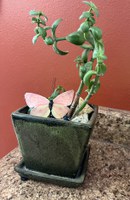Dakota Gardener: A turning plant story
(Click an image below to view a high-resolution image that can be downloaded)
By Carrie Knutson, Horticulture agent
NDSU Extension – Grand Forks County
While cleaning the kitchen one Sunday afternoon, my daughter asked why one of my houseplants looked like the letter “S.” Children always seem to find our faults. The plant I had hoped to hide until I could take some cuttings and re-start it this summer was put in the spotlight. However, it was a great opportunity for some plant-based learning for my daughter and a lesson for me.
The plant now in the spotlight is a jade plant that was purchased about six years ago. Originally, the jade was close to the patio door and was doing well. As I accumulated more plants, the jade plant got moved around the kitchen and now sits on the counter further away from the patio door.
Jade plants prefer bright, almost full sun, but not directly in front of a window. As a result of the move, my jade plant grew leggy. As the plant grew, it started to lean towards the light coming from the patio door. I rotated the container every time I watered in hopes that the growth would even out.
Eventually, the stems got so long that they started to tip over this past summer. For a quick fix, I propped up the stems with rocks. In the busyness of summer gardening, I forgot about the jade plant and the result is an “S” shaped plant.
Why did my plant “grow” down this road? Did you know plants are sneaky, and will turn and stretch toward the light? Phototropism is a plant growth characteristic responsible for plants turning towards a light source. This is especially important if the plant’s light requirements are not being met.
Low light levels also contributed to the odd shape growth. If the light source is too far away for the plant, in addition to turning toward the light, the plant will grow and stretch towards the light. The plant will have long spaces (internodes) between leaves (nodes). The plant may also have smaller leaves than normal. If light is severely lacking, the leaves may be white or yellow in color as not enough chlorophyll is produced.
I failed in the light department. But, did I do anything right for my plant? I didn’t over-water the plant, which is easy to do. Jade plants prefer well-drained soil. When I purchased the plant, it was potted in regular potting soil, so I repotted the plant in a succulent potting soil mix.
Maybe I should have added my jade plant to the list of gardening failures in my last column. On the bright side, I am turning my failure into learning. I will either learn about propagating jade plants or turn the plant into a bonsai. Thoughts? Happy gardening!
NDSU Agriculture Communication – Jan. 24, 2024
Source: Carrie Knutson, 701-780-8229, carrie.knutson@ndsu.edu
Editor: Kelli Anderson, 701-231-7006, kelli.c.anderson@ndsu.edu




